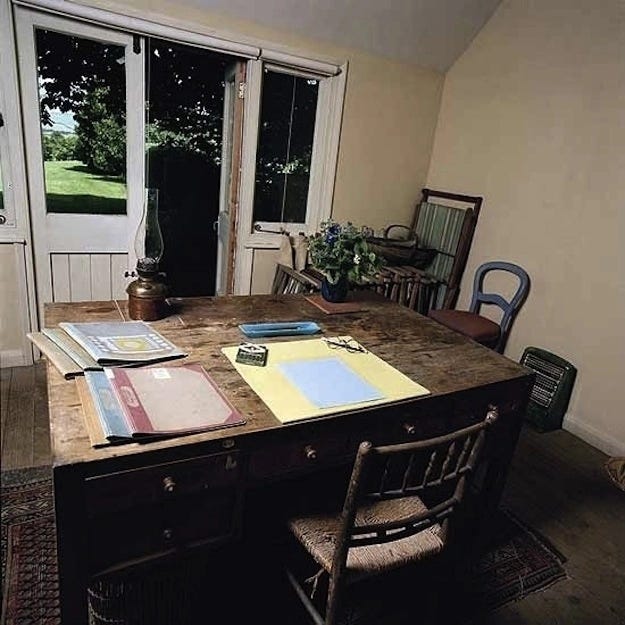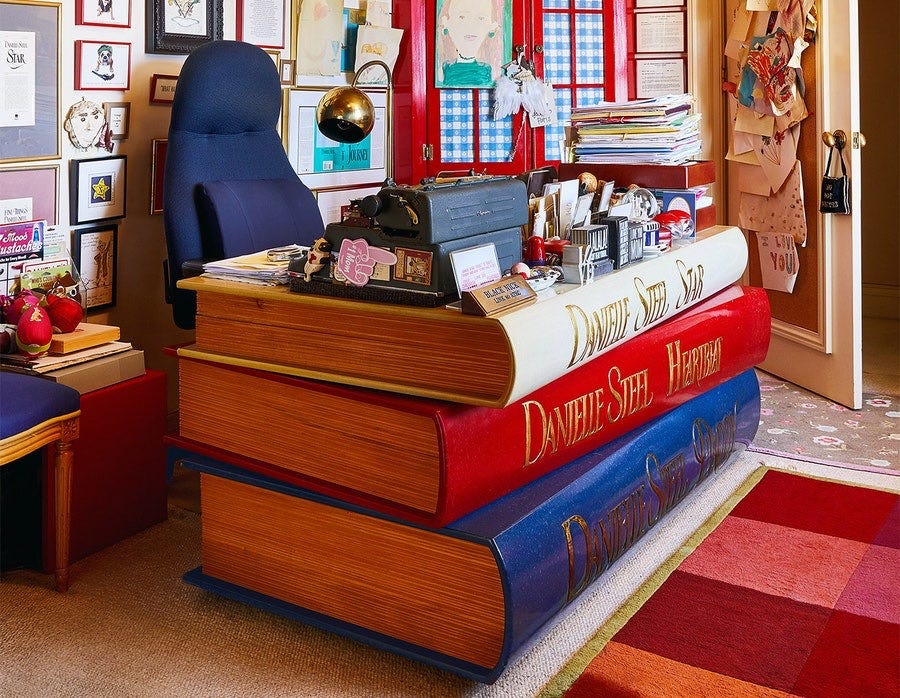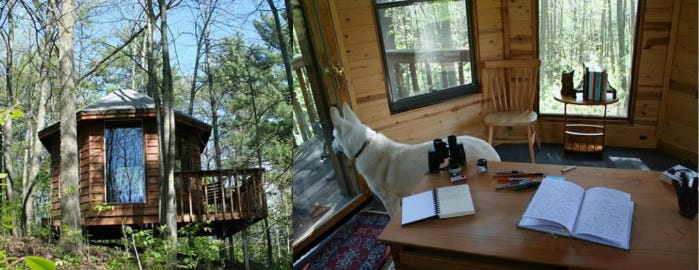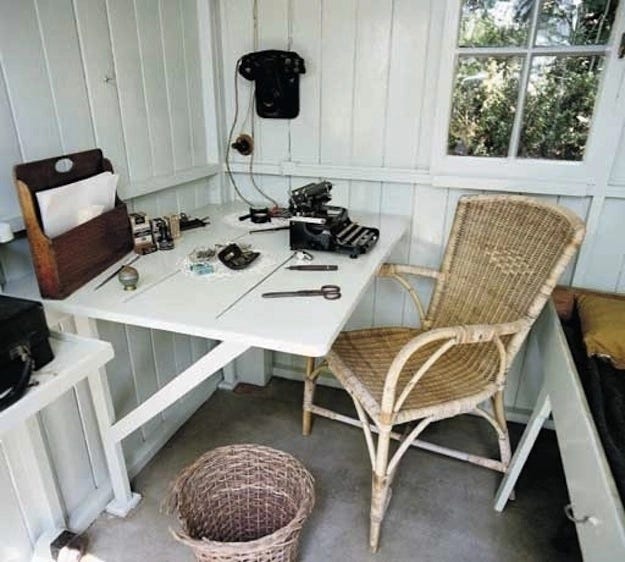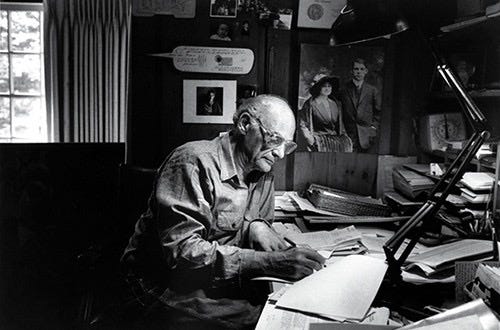Set the Scene: the Writer’s Creative Space
Lessons garnered from the ateliers of 10 masters of the written word
I can write pretty much anywhere, from cafés to sitting at home on an uncomfortable director chair at my kitchen table, dirty dishes taunting me from last night’s dinner. But in general, a clean room is preferable, and a comfortable chair, and table that’s the right height. Some writers prefer bright, busy coffee shops while other writers like near monastic silence. Some rent cabins to finish up edits, while others write from bed, without bothering to get dressed. But what’s the most effective writing location? What should writers do with their studios in order to make them the most effective writing spaces possible?
Let’s look at the writing rooms of some of the masters of the literary canon and some other very popular contemporary writers to see if there are clues to how and why they produced such lasting prose.
1. Ernest Hemingway
Master of the short sentence, setting a scene with just a few words, and a manly take-no-prisoners approach to life, Hemingway was actually quite a complicated man and writer. His writing room, one of a few he used through the years on his farm in Cuba, is really quite traditional. His desk, situated at one end of the room and looking out toward the door, recalls the office of a CEO or high-powered lawyer, but instead of legal books lining the shelves, Hemingway has fiction and nonfiction — a lot of it. He famously read veraciously and fast, sort of like his own writing. The room is also white and airy, with an open door looking out onto an interior patio, so he could have both fresh air and peace and quiet. Even though Hemingway is famous for drinking, he wrote sober, with the ocassional revision done with whiskey in hand.
The takeaway: fake it until you make it. Set up your writing desk like a boss.
2. Michael Pollan
Known best for his book The Omnivore’s Dilemma, and his catchphrase, “Eat food. Not too much. Mostly plants,” Pollan has recently been delving into experimenting with hallucinogens. His writing studio, a wood thatched tiny house perched above his Berkeley house in the woods, is most writers’ dream space, to be honest. With a generous window above his laptop and wooden shelves surrounding the space, I can imagine being in the space must feel like a warm hug, a cozy space that would equally enchanting in the winter as it would be in the summer, with the door and windows opened wide.
The takeaway: spoil yourself a bit. Build a backyard writing shed.
3. Jane Austen
Austen lived and wrote in England during the Victorian era, which may help to explain why her work space is so conservative, so very tiny, and so puritanical. A simple chair, a quill pen, and a small round table that would seem more suited to holding a drink than writing novels. None these, Austen created modern classics at this spartan table, which was situated by a window in a small upstairs study. What to learn from Austen’s workspace? You don’t need a big ergonomic chair and giant computer monitors to write — you just have to sit down to do it. You could be creating Sense and Sensibility, Pride and Prejudice, or Emma.
The takeaway: You only need a pencil, some scrap paper, and a nook to write. Don’t obsess over the details too much.
4. Virginia Woolf
Woolf, another English writer, had just a slightly more comfortable writing space than Austen, but not nearly as cushy as Pollan’s. Also housed in a backyard shed, Woolf said that in the winter, the writing shed got so cold, it was impossible to hold a pen. Maybe this isn’t the best writing space actually. Woolf famously put stones in her pocket and waded into a river to kill herself. But she created great works — Mrs. Dalloway and A Room of One’s Own among them
The takeaway: a depressing writing space may influence your writerly tone, so if your house is too dark or too cold, decamp to a cozy coffee shop.
5. Daniel Steel
Steel’s California office is pretty standard, with a out-facing executive desk placement and one of those ergonomic office chairs made to support your back and neck. The walls feature her book covers and framed sayings that she loves, including, since she works very late: ‘What hath night to do with sleep?’ Then there’s the desk. Steel had it custom made to look like three giant hardcover books (her own titles, chosen by her of course) in three bright colors. The desk is crammed full of stuff and Steel says she likes it that way. She has to move things out of the way every time she sits down to write. And she writes on an old fashioned typewriter by the way. Click, click, click… until yet another Danielle Steel novel is finished. By the way, she’s written 179 of them, so something about her work space must be conducive to creativity and production. Her titles, rich range from Going Home to Now and Forever, have sold in unprecedented numbers.
The takeaway: make your writing space anything you want it to be. Surround yourself in objects that inspire you.
6. Neil Gaimon
With its own mascot white dog and rustic wood siding, Gaimon’s Portland, Oregon writing studio is built on stilts in the woods behind his house, similar to Michael Pollan’s creative space. The author of Coraline and American Gods, Gaimon’s atelier is a bit more creative than Pollan’s though, with an octagon shape, an outside deck for reflection and breaks, and a nice big old wooden writing desk, complete with a pair of binoculars for occasionally spotting a rare bird or deer wondering by. With floor to ceiling glass, the outside and inside spaces are blurred in this cozy shed. I can only imagine how calming the sound of rain on the tin roof of this writing room must be.
The takeaway: a connection with nature, and a nice view, can help with both writing and creativity, so if you’re blocked, take a walk in the woods.
7. George Bernard Shaw
Shaw, a popular playwright responsible for over 75 plays, keeps his writing room simple, with a typewriter, a clean white desk and a small window in a private place. This is all housed in a shed in his back yard in Ayot Saint Lawrence, England. Privacy was key for Shaw, who once confessed, “People bother me. I came here to hide from them.” But given this statement, why does he have the private landline on the wall?
The takeaway: Isolation can be helpful, but don’t overdo it. Remember, writers need friends to draw from.
8. Mark Twain
This American treasure known for The Adventures of Tom Sawyer andAdventures of Huckleberry Finn, often cited as the great American novel, kept a writing room that was more like a clubhouse than office. Centered around a large billiards table in the center, Twain was said to have enjoyed mixing his writing time with this leisure time, often stopping to play pool, smoke cigarettes, or have a shot of whiskey. Twain later had an octagonal writing studio built on the campus of of Elmira College in upstate New York.
The takeaway: Breaks and distractions are important to the creative process, so play a game of pool, have a drink at the bar, or just call a friend on your writing breaks.
9. Arthur Miller
Miller’s writing room takes the womb approach, or perhaps you could also call it a nest. The author of the play Death of a Salesman and screenwriter of The Misfits, Miller’s cozy, cluttered room with dim light and lots of papers and books scattered everywhere worked for him. Photos and knickknacks and maybe an old bowling scorecard tacked to the wood paneled walls were his style. Miller liked to say that the appearance of his office matches the inside of his head, and the clutter made it easier to create.
The takeaway: clutter isn’t bad. Don’t expect an organized work station to equal organized work.
10. J.D. Salinger*
Salinger, a New Hampshire resident and a recluse since the publication of Catcher in the Rye, often writes in the nature that surrounds his house. He shows that you don’t need a chair, nor a desk, nor a computer, nor anything really to write a masterpiece.
The takeaway: Strip naked and take a nature bath while you write. It certainly can’t hurt the process and you’ll return to your laptop refreshed and revitalized.
*Just kidding. This photo is not in fact the ever reclusive J.D. Salinger, but rather a naturist called Jason Loam, but this shouldn’t stop you from experiencing the joy of writing in the nude.







